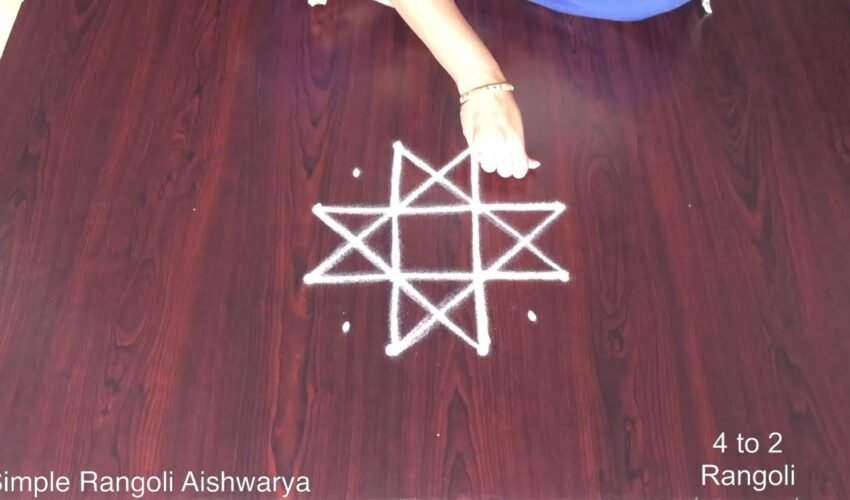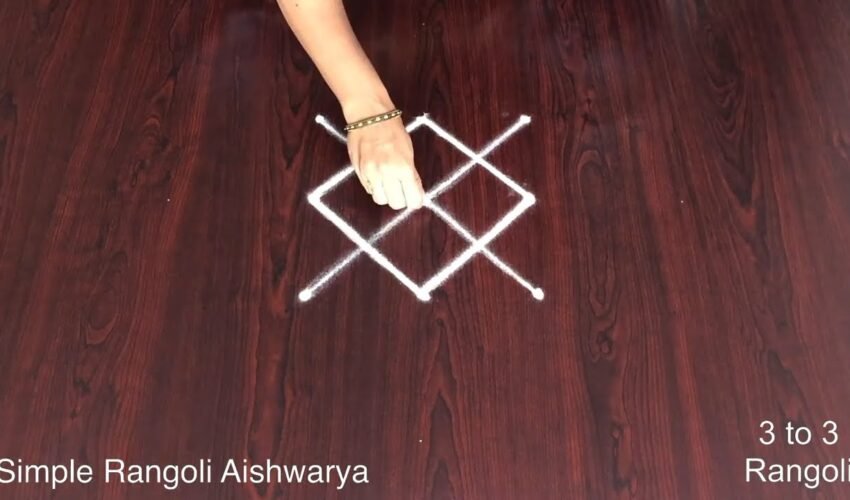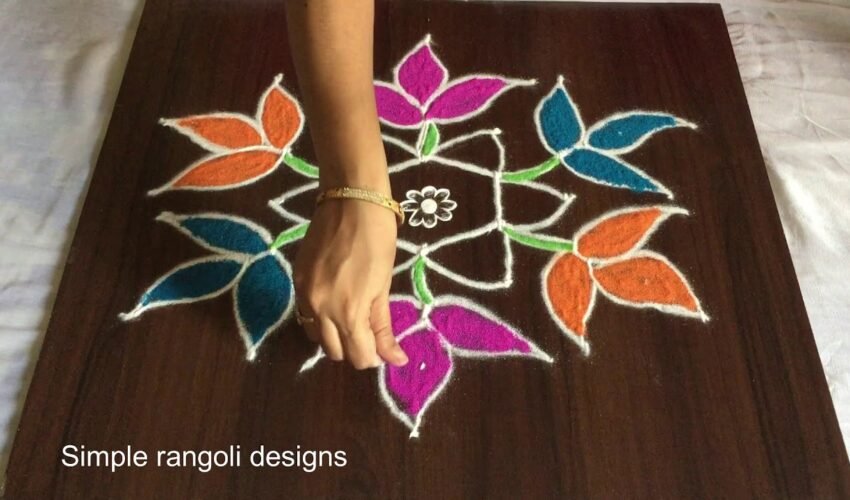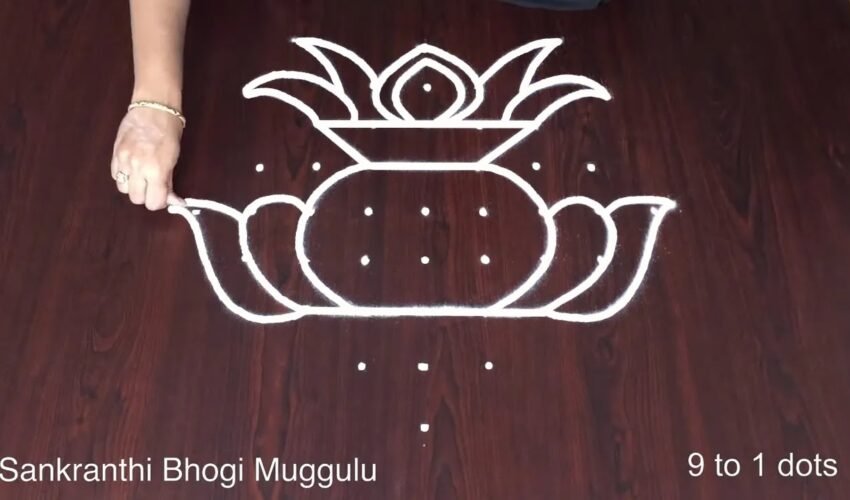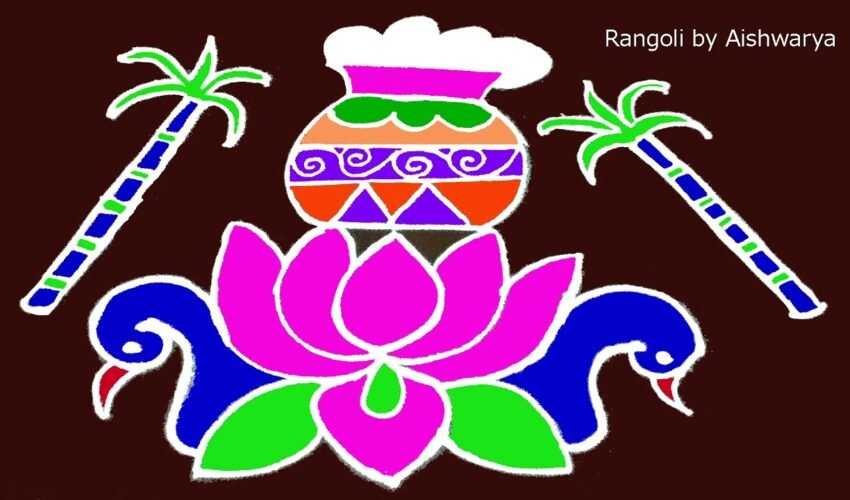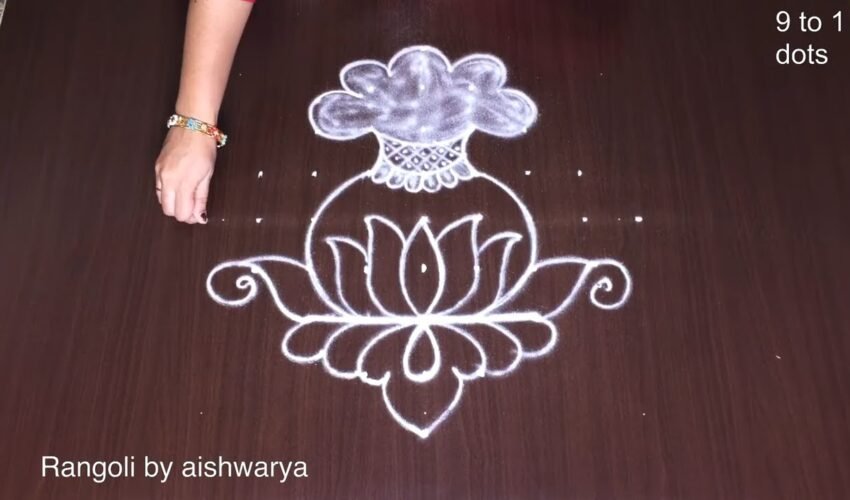The Ultimate Guide to Rangoli Designs
Step-by-Step Tutorials for Rangoli, Kolam, and Muggulu Designs with Inspiration
What is Rangoli?
Rangoli, a cherished Indian folk art, is a vibrant tradition handed down through generations, adorning floors of homes, courtyards, and public spaces with intricate, colorful patterns. Derived from the Sanskrit words “rang” (color) and “aavalli” (row or creepers), Rangoli means “rows of colors.” This ephemeral art form uses materials like powdered limestone, rice flour, colored sand, flower petals, and grains to craft stunning designs, embodying creativity and cultural heritage.
Deeply embedded in Indian culture, Rangoli is more than mere decoration; it holds spiritual significance. Creating these patterns at a home’s entrance is believed to invite prosperity, good fortune, and positive energy while repelling negativity. Each design carries symbolic weight, featuring geometric shapes, floral motifs, animals like peacocks or swans, and depictions of deities. Crafting Rangoli is a meditative act, fostering community and artistic expression as families and neighbors collaborate.
Particularly prominent during festivals like Diwali, Pongal, Onam, and Sankranthi, Rangoli transforms spaces into vibrant displays of color and creativity. Traditional designs often stem from dot-based grids, but modern interpretations embrace freehand styles and contemporary themes, reflecting evolving aesthetics. The choice of bright, vivid colors enhances visual appeal and conveys symbolic meanings tied to festivity and joy.
Types of Rangoli Designs
Some of the most popular types include Kolam, a traditional form from Tamil Nadu known for its complex symmetry and continuous lines, and Muggulu, the elegant, dotted patterns popular in Andhra Pradesh and Telangana. Beyond these, you’ll find Alpona from West Bengal, characterized by its delicate, flowing art, and stunning flower rangoli made with fresh petals for a natural touch. The world of rangoli also embraces modern rangoli designs, which use contemporary themes and stencils, making the art accessible to everyone. This section will guide you through the most prominent types, helping you discover the perfect design to express your creativity.
Kolam
Kolam is a traditional and highly respected form of rangoli from the Southern states of India. It is primarily known for its intricate patterns created with a grid of dots. The designs are drawn using rice flour, and they symbolize prosperity and positive energy. Kolam is often drawn daily at the entrance of homes and features symmetrical and complex patterns that are both aesthetically pleasing and spiritually significant. For a more detailed look, visit our dedicated Kolam Designs cluster page.
Muggulu
Muggulu is a popular form of rangoli practiced in the states of Telangana and Andhra Pradesh. Similar to Kolam, it is also based on a grid of dots, but the designs are often more free-flowing and artistic. Muggulu designs are typically drawn during festivals like Sankranti and are known for their beautiful, vibrant colors and elegant floral and geometric patterns. For more inspiration, visit our dedicated Muggulu Designs cluster page.
Rangoli Designs for Diwali
Rangoli holds a special and sacred place during the Festival of Lights, Diwali. These designs are a vibrant tradition created to welcome the goddess Lakshmi into homes, symbolizing prosperity, good fortune, and happiness. Diwali rangoli designs often feature auspicious motifs such as diyas (oil lamps), lotus flowers, swastikas, and intricate floral patterns. The use of bright colors like red, orange, and yellow is common, as they represent the festive spirit and the light that dispels darkness. For more inspiration, visit our dedicated Diwali Rangoli cluster page.
New Year Rangoli
Creating rangoli for the New Year is a wonderful tradition that symbolizes fresh beginnings and invites good luck and prosperity into the home. These designs are often characterized by their bright colors and contemporary themes that reflect a sense of renewal. Popular New Year rangoli patterns can include designs that incorporate the coming year’s number, geometric shapes, or traditional motifs that signify hope and new opportunities. This style allows for great creative freedom and is a beautiful way to welcome the new year with a positive and artistic expression. For more inspiration, visit our dedicated New Year Rangoli cluster page.
Kolam for Pongal
Kolam is an essential part of the Pongal celebrations, the four-day harvest festival of Tamil Nadu. These rangoli designs are created to honor the Sun God and express gratitude for a bountiful harvest. Unlike the daily Kolam, the designs for Pongal are often more elaborate and feature motifs related to the harvest season, such as sugarcane, sun symbols, and the traditional Pongal pot. The use of natural materials like rice flour and colored powders is common, making these Kolams a beautiful representation of the festival’s agricultural roots. For more inspiration, visit our dedicated Pongal Kolam cluster page.
Muggulu for Sankranthi
Muggulu for Sankranthi is a cherished tradition in the states of Andhra Pradesh and Telangana, where homes are decorated with large and elaborate designs to celebrate the harvest festival. These Muggulu often feature intricate patterns drawn with dotted grids, incorporating symbols of the harvest, such as sun symbols, sugarcane, and images of chariots. The Muggulu are traditionally filled with vibrant colors and are a beautiful way for families to express gratitude for a good harvest and welcome prosperity. For more inspiration, visit our dedicated Sankranthi Muggulu cluster page.
Vibrant & Colorful Rangoli
Vibrant and colorful rangoli designs are an explosion of creativity, focusing on the use of bold and bright pigments to create stunning visual art. Unlike the subtle tones of traditional rice flour designs, this style uses a wide palette of colored powders and pigments to bring patterns to life. Commonly seen during major festivals like Diwali, these designs often feature free-flowing, intricate patterns of flowers, geometric shapes, and festive motifs that radiate joy and celebration. For more inspiration, visit our dedicated Colours Rangoli cluster page.
Step-by-Step Guide: How to Create a Rangoli
- Choose a Location: Select a clean, flat surface like a home entrance or courtyard. Clean and dry the area.
- Plan the Design: Pick a simple (geometric) or complex (floral, mandala) pattern based on skill level. Sketch or use a stencil if needed.
- Draw the Outline: Use white rangoli powder, chalk, or rice flour to create the base design (dots or freehand).
- Fill Colors: Apply colored powders (e.g., red, yellow, green) with fingers or spoons, starting from the center.
- Add Details: Enhance with flower petals, diyas, or beads for texture and tradition.
- Finalize: Clean edges, check symmetry, and make adjustments for a neat finish.
- Display: Protect from wind and enjoy the vibrant, festive art!
Tips and Tricks for Perfect Rangoli
- Plan Your Design: Sketch your Rangoli on paper first, choosing simple geometric or floral patterns for beginners or intricate ones for experts. Ensure symmetry for traditional styles like Kolam or Muggulu.
- Prepare the Surface: Clean and sweep the floor to create a smooth, even canvas. Lightly dampen the surface for better adhesion of rice flour or powders.
- Use Quality Materials: Opt for finely ground rice flour, vibrant colored powders, or fresh flower petals. Sieve powders for smooth application and vivid colors.
- Master the Technique: Practice pinching rice flour between fingers for precise lines in Kolam or Muggulu. Use stencils or spoons for even distribution in complex designs.
- Start with a Grid: For traditional designs, create a dot grid with chalk or flour as a guide to ensure symmetry and proportion.
- Layer Colors Wisely: Apply lighter colors first, then darker ones to avoid smudging. Use contrasting hues for visual impact.
- Add Finishing Touches: Enhance with diyas, glitter, or small mirrors for festive flair, especially for Diwali or Pongal designs.
- Practice Patience: Work slowly to maintain precision. Creating Rangoli is meditative; take time to enjoy the process.
- Protect Your Design: Place Rangoli in low-traffic areas or use a light fixative spray (for powders) to preserve it longer.
- Clean Up Smartly: Use a soft brush or cloth to clean mistakes without disturbing the design. Sweep gently after the event to avoid scattering powders.
Frequently Asked Questions
What is Rangoli, and what is its cultural significance?
Rangoli is a traditional Indian folk art where colorful patterns are created on floors using materials like rice flour, colored sand, or flower petals. Derived from Sanskrit words “rang” (color) and “aavalli” (row), it symbolizes prosperity and positivity. Drawn at home entrances during festivals like Diwali, it invites good luck and wards off negative energy. The process fosters creativity and community, blending spirituality and artistry in intricate designs.
What are the key features of Rangoli designs?
Rangoli designs are intricate, symmetrical patterns often featuring geometric shapes, floral motifs, animals, or deities. Created with materials like powdered limestone, rice flour, or petals, they use vibrant colors for visual appeal and symbolic meaning. Traditional designs rely on dot grids, while modern ones may incorporate freehand styles or stencils. Each design reflects cultural heritage, inviting prosperity and positivity, especially during festivals.
What is Kolam, and how does it differ from other Rangoli styles?
Kolam is a traditional Rangoli style from Tamil Nadu, known for its symmetrical patterns drawn with continuous rice flour lines. Unlike other Rangoli forms that may use vibrant colors or varied materials, Kolam focuses on monochromatic, intricate designs created daily at home entrances. Its simplicity and precision distinguish it, symbolizing purity and welcoming positive energy.
What are Muggulu designs, and where are they popular?
Muggulu, a Rangoli style popular in Andhra Pradesh and Telangana, features elegant patterns drawn from dotted grids using rice flour or chalk. These designs often include geometric shapes or floral motifs, created during festivals like Sankranthi. Muggulu are known for their precision and symmetry, transforming spaces into vibrant displays of cultural heritage.
What are simple Rangoli designs, and who can create them?
Simple Rangoli designs are beginner-friendly patterns using basic geometric shapes, small floral motifs, or minimal dot grids. Created with rice flour, colored powders, or petals, they require little skill, making them ideal for novices or quick decorations. These designs are perfect for daily use or small celebrations, offering a vibrant yet easy way to embrace the tradition.
What are the characteristics of Kolam designs?
Kolam designs, originating from Tamil Nadu, are intricate, symmetrical patterns drawn with continuous rice flour lines. Typically monochromatic, they use dot grids to create geometric or curvilinear shapes, symbolizing purity and prosperity. Drawn daily at home entrances, Kolam designs are meditative, fostering discipline and creativity while welcoming positive energy.
What makes Muggulu designs unique?
Muggulu designs, prevalent in Andhra Pradesh and Telangana, are crafted from dotted grids using rice flour or chalk. Their uniqueness lies in their precise, symmetrical patterns, often featuring floral or geometric motifs. Created during festivals like Sankranthi, Muggulu combine elegance and cultural significance, transforming spaces with vibrant, intricate artistry.
What are popular Rangoli designs for Diwali?
Diwali Rangoli designs feature vibrant, elaborate patterns like diyas, lotus flowers, peacocks, or geometric mandalas. Using bright colored powders, rice flour, or petals, these designs enhance festive ambiance at home entrances. They symbolize light, prosperity, and joy, often incorporating intricate dot grids or freehand styles for a celebratory touch.
What are Sankranthi Muggulu, and how are they created?
Sankranthi Muggulu are traditional Rangoli designs from Andhra Pradesh and Telangana, drawn during the Sankranthi festival. Created with rice flour or chalk on dotted grids, they feature geometric patterns, floral motifs, or cultural symbols like kites. These vibrant designs celebrate harvest and prosperity, adorning homes with festive charm.
What is Pongal Kolam, and its significance?
Pongal Kolam is a Tamil Nadu tradition drawn during the Pongal harvest festival. Using rice flour, these symmetrical, continuous-line designs feature pots, sugarcane, or floral motifs, symbolizing abundance and gratitude. Created at home entrances, Pongal Kolam invites prosperity and fosters community spirit, reflecting Tamil cultural heritage.
